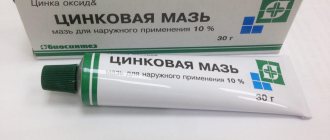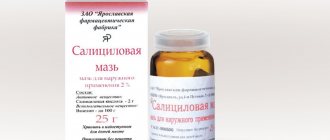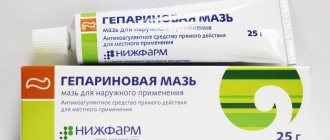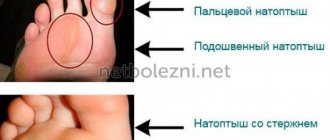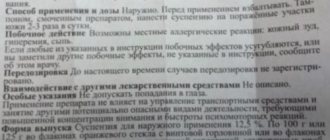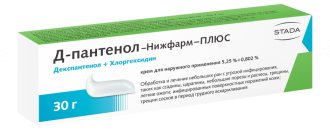Zinc ointment is one of the best remedies in the fight against diaper rash, excessive sweating and acne. It provides the necessary skin care, disinfecting and protecting from external adverse factors. The low price makes it accessible to consumers, and the low percentage of allergic reactions gives it the right to be called safe for babies.
How to use zinc ointment
Zinc ointment is used in pediatrics as a protective agent against diaper rash. In addition, it is recommended to lubricate the baby's delicate skin under the diaper every time after bathing. Zinc creates a reliable barrier that protects children's skin from constant contact with urine and loose stool. By applying zinc ointment to the buttocks daily, you can protect your baby from diaper dermatitis.
The disinfecting effect of the drug is used when treating wounds. By applying the composition to abrasions, you can avoid infection, prevent acidification of the damaged surface, and speed up the process of skin regeneration.
The main indications are:
- diaper rash;
- scratches;
- dermatitis;
- eczema;
- cuts.
In addition, zinc ointment is used to care for the elderly and immobile patients. Treatment of bedsores slows down their spread and disinfects, which eliminates the risk of secondary infections.
Zinc paste and ointment - description
Zinc is a mineral
, without which the human body cannot exist. It takes part in cell division, helps tissues regenerate, is part of proteins, and helps the formation of blood cells. If there is not enough zinc in the body, even minor injuries take a long time to heal, and the skin often develops dermatitis. Read detailed information about zinc ointment.
Zinc ointment and paste - preparations
, which contain zinc oxide.
The properties of this mineral were the basis for the creation of drugs that have a number of positive effects:
- heal wounds, abrasions;
- dried;
- destroy the infection, etc.
The ointment with zinc is quite thick and has a white, white-yellow tint. Cosmetic Vaseline is present as an additional ingredient. Some, "Acri", "Pharmaktivy Capital", "Mikfarm" and others) add other substances to give a more pleasant smell and provide an additional softening effect:
- fish fat;
- dimethicone;
- lanolin;
- menthol;
- essential oils.
Zinc paste or ointment, which is better?
Zinc paste differs from ointment in thickness; it is denser, since there are more powdery substances in it. Due to its thick consistency, the paste penetrates tissues less well, but does not have a systemic effect at all. Therefore, the paste is recommended for use in acute cases, when cell permeability is increased. The ointment is best used for chronic conditions; it penetrates perfectly into deep tissues. The price of the paste (25 g) is 120 rubles. The ointment costs 80 rubles for 30 g.
How does zinc ointment work on acne?
Use in cosmetology has shown its effectiveness against acne. Skin rashes caused by excessive secretion from the sebaceous glands may disappear if zinc ointment is used correctly:
- Cleanse skin of makeup and impurities.
- Wipe skin dry.
- Apply zinc ointment to the area affected by acne.
- Leave overnight.
Zinc will dry out areas of the skin and prevent the sebaceous glands from producing sebum.
Zinc paste - indications for use
The range of skin diseases for which this product can be used is so wide that it is difficult to compile a list of all pathologies.
The instructions that come with the zinc paste drug indicate the following indications for its use:
- diaper rash;
- "diaper" rash;
- prickly heat;
- dermatitis;
- ulcerative skin diseases;
- superficial wounds;
- exacerbation of eczema;
- herpes;
- trophic ulcers on the skin;
- streptoderma;
- burns;
- bedsores.
Do I need to wash off zinc ointment from my face?
The constant presence of zinc on the skin of the face can lead to dryness and flaking. However, this depends on the individual characteristics of the sebaceous glands. If pathological activity is noted, the zinc ointment may not be washed off, but in this case there is no need to apply foundation and other cosmetics on top of it: firstly, this will clog the pores, and secondly, the compositions of some products may react with zinc, which may lead to chemical reactions between components.
If the ointment is not washed off during the day, be sure to cleanse the skin by washing before the next application. Otherwise, the accumulation of daytime dust in the pores with ointment residues can give rise to a new skin problem.
Analogues and other information
How many analogues of the product are there in pharmacies? There are not so many of them, some have a higher price compared to Zinc ointment and paste.
| A drug | Composition (main components) | Price, rubles |
| Desitin | Zinc oxide | 260 |
| Tsindol | Zinc oxide | 160 |
| Zinkundan | Zinc undecylenate, salicylanilide | 450 |
| Salicylic-zinc paste | Zinc oxide, salicylic acid | 85 |
| Diaderm | Zinc, essential and base oils | 170 |
Overdose of this drug is impossible; no cases have been reported. , dark pigment spots may appear on the skin.
, which should be taken into account when treating various chronic pathologies of the face and body.
You should not overuse ointment to treat acne on the face - it can cause severe drying of the skin.
Sometimes it can be difficult to wash off Zinc ointment or paste from the skin of the face; in this case, it is recommended to use tar soap. On the contrary, patients with dry skin should use only special nourishing washes, milk, tonics, and after the procedure apply a moisturizer to the face.
Contraindications
The ointment is not used to treat skin diseases in patients prone to allergic reactions to the components of the drug.
Zinc ointment is not applied to the mucous membranes of the mouth. Once zinc enters the bloodstream through the esophagus, it can cause poisoning, which can lead to convulsions, allergic skin reactions, nausea, vomiting and dizziness. Exceptions may be the mucous membranes of the anal ring and foreskin, where the ointment can be applied to relieve the inflammatory process, accelerate the healing of cracks and disinfect the surface.
Effect of the drug
The main active component has an astringent, anti-inflammatory, and antiseptic effect. Zinc oxide, when applied topically to the skin, can destroy a wide range of different bacteria, as it negatively affects the proteins of their cells. Ultimately, this causes the death of microbes. Of course, the drug is not an antibiotic; if the infection process is active, it will be powerless, but it is able to disinfect the surface of the skin.
WE RECOMMEND THE ARTICLE!
Lorista is prescribed in the presence of hypertension - an uncontrolled increase in blood pressure. Read more >>
Other beneficial properties of zinc oxide are based on the following:
- Astringent and healing effect
. The mineral destroys the structure of proteins and amino acids, and a thin film appears on the surface.The skin and mucous membranes under the film are protected and heal faster.
- Anti-inflammatory effect
. Due to a decrease in skin infection and drying, inflammatory processes subside. The deeper layers are not involved in inflammation. - Adsorbent action
. This is especially true for zinc paste. Due to the presence of a large number of powdery substances, the latter absorb harmful elements and decay products of microbes.
Additional components of ointments and pastes are needed not only to give the desired dosage form. They soften the effect of the medicine, preventing excessive drying of the skin and mucous membranes.
[media=
https://youtu.be/E-LrLc4gmyY
]
How to use zinc ointment for sweat
Excessive sweating is a problem that zinc ointment helps combat. Violation of the function of thermoregulation leads to excessive production of sweat by the glands, due to which the body tries to reduce body temperature. Zinc ointment does not affect the center of thermoregulation, however, it can reduce the activity of the sweat glands, thereby reducing the amount of sweat produced.
It should be noted that the sweat produced by humans is odorless. The waste products of bacteria that multiply in the armpits, which contain a favorable environment for the proliferation of microorganisms, smell. Zinc ointment, having an antiseptic effect, reduces the rate of bacterial growth, thereby eliminating unpleasant odors.
Zinc paste
Registration number: R No. LSR-004520/10
Trade name of the drug: Zinc paste.
INN or group name: Zinc oxide.
Dosage form: Paste for external use
Composition per 100 g of paste: Active substance:
- Zinc oxide (zinc oxide) 25.0 g
Excipients:
- Potato starch 25.0 g,
- Vaseline (medical petroleum jelly) up to 100.0 g
Description: Paste from white to white with a yellowish tint.
Pharmacotherapeutic group: Dermatoprotective agent.
ATX code: D02AB
Pharmacological properties: Anti-inflammatory agent for external use, has an antiseptic, astringent and drying effect. When used in children, it helps prevent diaper rash, protects against urine and other irritants, and softens irritated skin. Reduces exudation and wetting, which relieves local inflammation and irritation. The symptomatic and protective effect of the drug is determined by zinc oxide. Zinc oxide, combined with petroleum jelly, creates a physical barrier, forming a protective coating on the skin that reduces the impact of irritants on the affected area and prevents rashes.
Indications for use: Treatment and prevention of diaper rash. The drug is also used as a first aid remedy for minor skin injuries (minor burns, cuts, scratches, diaper rash).
Contraindications: Increased individual sensitivity to the components of the drug.
Directions for use and dosage: For external use only. Diaper rash in children from infancy.
Treatment: Wash and dry the affected area before use. When the first signs of redness, diaper rash or slight skin irritation appear, the paste is applied 3 or more times a day, as needed, usually with any diaper (diaper) change.
Prevention: Apply to the skin covered with a diaper or diaper before signs of irritation begin, especially before bedtime, when the child can stay in wet diapers for a long time. Cuts, scrapes and burns. Apply a thin layer, apply a gauze bandage if necessary. Apply only to superficial and uninfected lesions.
Side effects: Hypersensitivity reactions to the drug are possible: itching, hyperemia, allergic reactions at the sites where the paste is applied.
Overdose: Not known.
Interaction with other drugs: Not known.
Special instructions: The paste is for external use only. Avoid contact with eyes. The paste should not be applied if there is an infection in areas of damaged skin.
Release form: Paste for external use 25%. 25 g in orange glass jars. Each 25 g jar, along with instructions for use, is placed in a box of cardboard. It is allowed to place jars together with an equal number of instructions for use in a group package. 2.0 kg in jars with polyethylene terephthalate lids or polyethylene terephthalate jars with polyethylene lids; 20 kg in polyethylene bags, the bags are placed in metal cans (for the production departments of pharmacies).
Shelf life: 5 years. Do not use after the expiration date stated on the packaging.
Storage conditions: Store in a place protected from light, at a temperature not exceeding 20 °C. Keep out of the reach of children.
Conditions for dispensing from pharmacies: Without a prescription.
Analogue drugs
Substitutes for zinc paste are medicinal ointments such as Desitin and Tsindol . These are well-known drugs, the active ingredient in which is zinc oxide, as in the paste.
The disadvantage of these drugs is their high price. Although their scope of application is identical to zinc paste.
Zinc paste is an affordable folk remedy for the treatment of acne , acne, dermatitis, burns and other skin damage. This medicine quickly dries, relieves redness and inflammation under the skin.
Its therapeutic effect will be achieved only if a person begins to apply the paste according to the rules: on clean, disinfected, dry skin .
Despite all the safety of zinc paste and the absence of contraindications, it should be used only after consultation with a dermatologist or cosmetologist.
How to quickly and with what to wash off zinc paste?
Many women encounter a problem when using this product - they cannot wash off the paste properly . It is especially difficult for those people whose skin peels where the drug is applied. Then it seems that it is impossible to wash off the product.
But here the following drugs can come to the rescue:
- Tar soap . It effectively removes paste residues the first time. In addition, tar soap heals the skin and fights excessive oiliness of the skin. It can only be used for oily skin types.
- Salicylic or boric alcohol . It is suitable for those people who have dry skin type. It is enough to dip a cotton swab in such alcohol and wipe the problem areas with it. Zinc paste is easily washed off and will not leave any traces behind.
- Vegetable oil . To wash off the remaining paste easily and painlessly, you can first apply vegetable oil to the skin.
